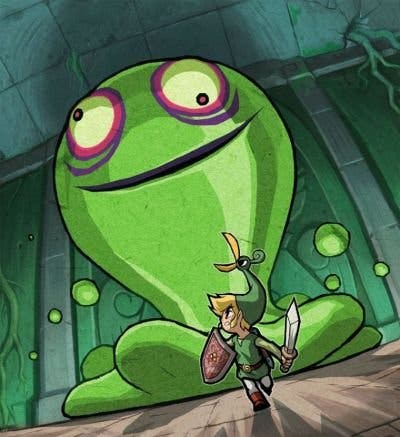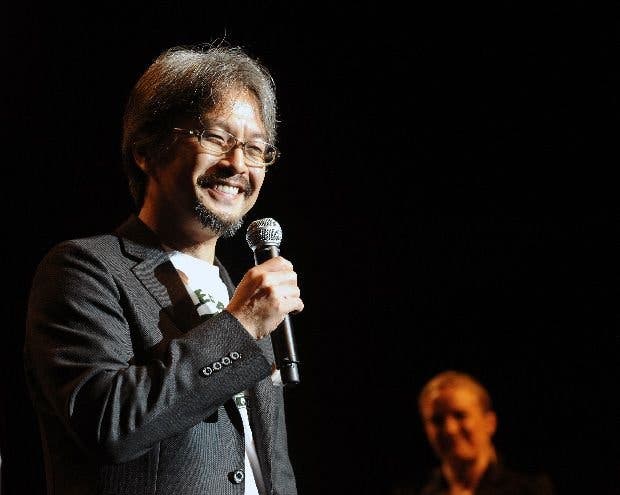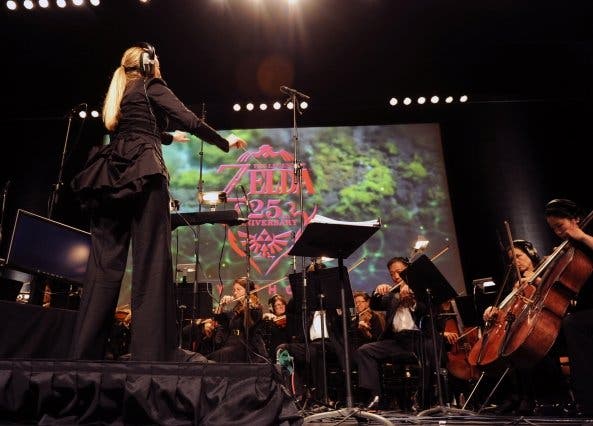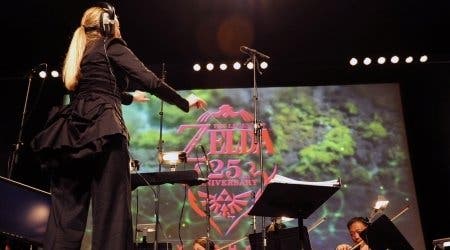Music Week: A Hero's Journey
A return to music and magic.
Next up in Music Week we're bringing you this lovely piece from 2011, all about the various leitmotifs that pull together a true gaming great.
London, October 2011. Thousands are crowded into the Hammersmith Apollo, one of the city's most famous theatrical venues, to hear a concert of music commemorating the 25th anniversary of The Legend of Zelda. It's an emotional night. Host Zelda Williams recalls how much the series she was named after meant to her growing up, and her voice audibly cracks at the memory. As Koji Kondo plays a delicate piano solo of Grandma's Theme from The Wind Waker, grown men can be seen dabbing their eyes. Kondo rises from his seat and the audience stands, too, applauding wildly, a number of them clad in the familiar green tunic, tights and pointed hat of their hero.
How did this simple fairytale fantasy inspire such passion, such devotion?

Kyoto, 1986. Buoyed by the success of Super Mario Bros. a year earlier, game designers Shigeru Miyamoto and Takashi Tezuka are putting the finishing touches to their latest creation, The Legend of Zelda. It is designed to be Mario's polar opposite: a slow-paced adventure with multiple routes open to the player. Despite complaints that such an approach will prove confusing to players, Miyamoto bullishly reinforces his decision by removing the sword from the player's inventory at the outset. The reason: he wants players to communicate, to share ideas on how to beat the game. Even from the start, The Legend of Zelda was designed to be a game that people would talk about.
The first seeds of its development were sown in the mind of a young Miyamoto as he explored local forests and caves as a boy, "stumbling on amazing things". It wasn't just the great outdoors that provided rich creative material: childhood memories of being lost in the labyrinth of shoji doors and tatami floors of his family home were the inspiration for Zelda's dungeons.
But it was Tezuka who tied Miyamoto's ideas together with the original Zelda story. It was and is a guilelessly traditionalist fairy tale, a love letter to traditional fantasy yarn-spinning. And while later Zeldas have piled on complexities and subtleties, at its core the series has always been about a young boy saving a princess - and, by extension, the world - from the forces of evil. It's a different Link each time, but the story remains the same, and there's a comforting familiarity to the routine. In a medium full of conflicted protagonists, Link remains a steadfast, stoic constant; a selfless hero in a selfish world.
If the original set up the template, it was A Link to the Past that mastered it, introducing a number of elements that are now Zelda tradition - the dual-world mechanic, the hookshot, the Master Sword, the spin-attack, the hidden heart container pieces that rewarded thorough exploration of this expanded Hyrule.
As a worldly-unwise teenager without access to a SNES (consoles weren't allowed in our house because they had no higher purpose than playing games; at least with an Amiga my parents could pretend it would be used for schoolwork) this was my formative Zelda experience, and it was mostly a passive one. I enviously watched my friend stab chickens, smash vases and swipe grass for rupees, snaffling the occasional few minutes here and there during toilet and tea breaks for my pad-hogging host. It was enough to make the likes of Sensible Soccer and Alien Breed feel frivolous and unsatisfying when home-time came. Needless to say, for two glorious weeks in October 1992, I spent much more time at my friend's house than my own.
If A Link to the Past proved Nintendo's mastery of two dimensions, Ocarina proved it was equally comfortable in the brave new era of 3D. Many games have sold better than Ocarina, but few are so fondly remembered. Again, the boundaries of Hyrule were widened; again, Nintendo wasn't afraid to let go of the player's hand and allow them to get lost.

Perhaps more than any other Zelda, it captured what Miyamoto had been aiming for since the series' inception - that sense of discovery, of wonder. Stepping out onto Hyrule Field for the first time felt as much a rite of passage for a generation of gamers as for the character they were controlling. Back in the Hammersmith Apollo, the Royal Philharmonic Concert Orchestra launches into a stirring rendition of its famous theme, and thousands of attendees feel a brief shiver beginning at the nape of their neck.
Majora's Mask (Zelda's favourite Zelda, as our adorably nervy host informs us) was a race against time in more ways than one. The rush to create a new Zelda from what began as Ocarina's Master Quest was mirrored in the game's three-day system, and we were rewarded with a more intimate, personal Zelda than before, one that some would say has aged better than its more celebrated predecessor. The setup brought Link's altruistic side to the fore, with a number of memorable character-led quests - like reuniting star-crossed lovers Anju and Kafei - that established this key theme of helping others that had always been a part of Zelda, but perhaps never quite so obviously prevalent.
The frequency of its human interactions also threw Link's status as a silent protagonist into sharper relief. We all refer to him as Link, but he's an extension of ourselves: not for nothing does Nintendo allow us to name the hero as the adventure begins. He may not a character we can necessarily empathise with - though his own setbacks echo life's little impediments - but more an idealised version of ourselves, the kind of guy we all secretly want to be. Arguably more than any other Zelda to date, it's the characters that Link reacts to - and how they react to him - that defines him as a character.
The undulations of The Great Sea midway through The Wind Waker Symphonic Movement stir fond recollections of the first Zelda I played from start to finish. They say your first Zelda is the best one, and, eight years on, it remains for me the series highpoint. Ironically, it arrived at a painful time in my life, as a botched operation left me housebound for two weeks, for what turned out to be a fortuitous fortnight of ocean adventures; of swaggering Moblins and statuette sidequests, of Triforce hunts and cel-shaded curlicues. It remains one of the most beautiful games ever made, and early forum rage surrounding its bold visual direction now seems rather foolish.

Yet such vitriol speaks volumes about Zelda fandom. It's astonishing that an expansive and popular series can feel so personal to so many, yet the stinging criticisms that emerged when the first Wind Waker footage was unveiled were borne from a burning passion for the series. How dare Nintendo do that to our game!
But think about it: Zelda isn't really for us. Each new Link represents a new generation, a fresh hero for a fresh audience of wannabe heroes. There's a reason for Zelda's rituals and routines; it's a legend passed down, a story told through generations.
As the strings swell on the Twilight Princess version of the Kakariko Village theme, underneath the multi-layered arrangement you can hear that same familiar melody from A Link to the Past, the same MIDI notes Koji Kondo composed all those years ago. The music is just another part of the ritual, as the nostalgic laughter that greets orchestral takes on that four-note fanfare and that eight-note jingle proves.
With Aonuma a little too preoccupied with toppling Ocarina - a quest to slay his own personal Ganon, you could say - Twilight Princess perhaps represents the most tentative step forward for a home console Zelda. It's a little too in thrall to its predecessors; a Chinese Whispers retelling of Ocarina. But to a generation of players it is a majestic coming-of-age tale, a story of good triumphing over evil, of a green-garbed hero with a sword, a shield, a horse and the dozens of hours of memories that exploring his kingdom has left them with. Your first Zelda is the best one, remember?

Four days after the concert, I attend the 25th anniversary celebrations in GameCity. A snaking queue waits outside a huge tent for a brief early play of the newest Zelda, Skyward Sword. Inside, a group engages in play swordfights, each clash of wooden blades soundtracked by Link's familiar cries. A girl dressed as Malon poses for a photograph; a woman paints Tingle on a Hylian shield; a young man carries a huge piece of card bearing a hand-drawn 8-bit Link sprite on his back.
There's a happy, convivial atmosphere that says much about the real culture of Zelda. The knitted Etsy hats and gloves, the cardboard swords and shields and the Triforce tattoos are just part of it; it's evident in the virtues the games have taught their players: patience, kindness, generosity. The free Zelda Zine handed out to 200 attendees, and featuring contributions from well-known artists and journalists as well as fans, epitomises the spirit of Zelda.
A mother tells me her seven-year-old won't be at school on 18th November: another Hero of Time passing the Triforce of Courage to a new Link. Later this month I'll be doing the same as I play Skyward Sword with my own son. Perhaps, in 25 years time, he'll attend a commemorative concert for Zelda's 50th anniversary. Perhaps he'll hear the plucked harp strings heralding the introduction of the main theme and feel that same shiver beginning at the nape of his neck. Perhaps I'll be there beside him, sharing in the joyous escapism this legendary series has brought to generations of gamers.

